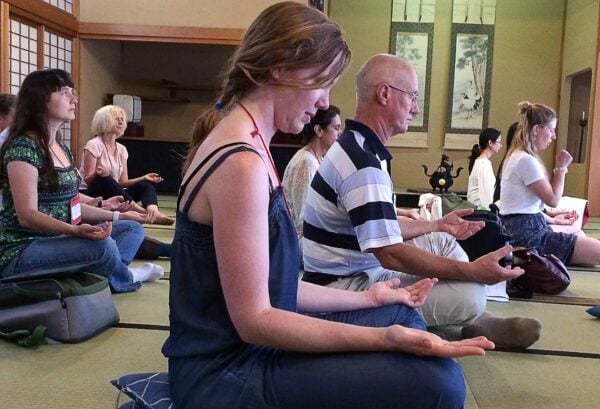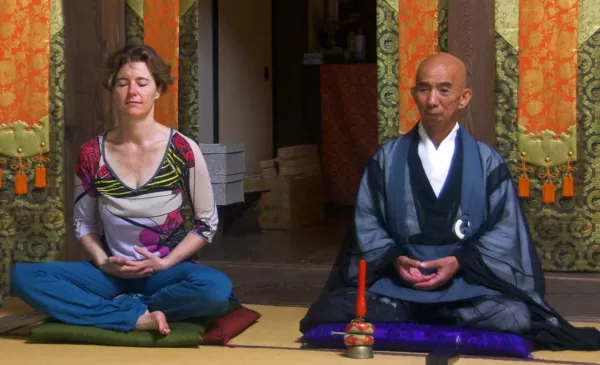Meditation is intended to help people bring their minds under control, find lasting inner peace and experience happiness. However, many people find it difficult to meditate daily. Reasons often mentioned as obstacles include: “I can’t find the time to do it,” “I can’t calm my mind,” “My thought carousel won’t stop,” or “Meditation just doesn’t work for me.” You actually want to reduce daily stress through meditation; but it is also the stress that prevents them from doing this. How can one gets out of this loop and overcome possible difficulties? How can one become mindful out of habit?
Find support in a community
Digital solutions seem to be available for every type of project. It’s the same with meditation apps. The big advantage of the apps is their permanent availability. It can be accessed at any time and the instructions are always available. The big disadvantage is that you are alone. People have been meditating in groups for thousands of years. In Buddhism, such communities are called sanghas. Meditating in groups offers two advantages: Firstly, you are committed because appointments are arranged in the group. Secondly, you receive support from the group by realizing that other people are facing the same challenge.
Matthias Birk is a professor of leadership and mindfulness at New York University and has been practicing meditation for 20 years. says that  most people who have made meditation an integral part of their daily lives and have found a solid foundation in the community. Sitting in a community provides structure to ensure they practice regularly. In the USA, for example, managing directors of large companies promote such group meditations. Hundreds of employees meditate together via conference call. Google itself founded such a community, the Chade-Meng-Tang Group (HBR, 20.11.20). Members confirm that exercising together in a like-minded group allows individuals to find peace and space very quickly.” There is also a wide range of group meditation options in Switzerland.
most people who have made meditation an integral part of their daily lives and have found a solid foundation in the community. Sitting in a community provides structure to ensure they practice regularly. In the USA, for example, managing directors of large companies promote such group meditations. Hundreds of employees meditate together via conference call. Google itself founded such a community, the Chade-Meng-Tang Group (HBR, 20.11.20). Members confirm that exercising together in a like-minded group allows individuals to find peace and space very quickly.” There is also a wide range of group meditation options in Switzerland.
Commit to a fix time for meditation training
Remember how, as a small child, you perfected your ability to walk after crawling unsteadily and standing unsteadily. Or how you may have refined your technique in a specific sport, or how you could play melodies with a musical instrument: everything was only possible through countless repetitions. In his book “On the Still and Clear Mind,” Claude Mannewitz (2019) says that with increasing practice, the mind gets used to pausing and being present – it can’t help but learn if you repeat an activity over and over again.  However, regular practice requires some discipline and a commitment, i.e. the promise not just to stick to the intention, but to stick to the planned deadlines.
However, regular practice requires some discipline and a commitment, i.e. the promise not just to stick to the intention, but to stick to the planned deadlines.
Matthias Birk says: Setting a reliable date for your personal practice is crucial. He tells of Patrick, manager of a global investment bank, who did this immediately after his introductory meditation course. He told his team that 3:00 p.m. was his daily uninterrupted meditation time and blocked off the free time on his calendar. Every afternoon he closes the door of his office and meditates for 20 minutes. All employees can see him meditating through the glass windows of his office and know that he is then unresponsive (HBR, 20.11.20).
Work with a teacher
Children don’t need an explanation to crawl, stand and walk. They observe and imitate other children and adults. Our genes help with this, allowing learning processes to take place like a software program. This occurs particularly during childhood and youth. Children simultaneously learn even two or three languages without any effort. However, as you grow up, learning becomes increasingly difficult. In order to play tennis, golf or piano at a high level, the support of a teacher or trainer is necessary. Of course, as a talented self-taught person, you can acquire certain skills on your own. With a teacher who observes you, explains necessary things to you, and gives you feedback, the learning process is supported and occurs more thoroughly, so that it is possible to achieve a high level of competence. The same applies to meditation. As meditation becomes increasingly easier, you become mindful in everyday life out of habit.
After a few weeks or months of practice, you may find yourself frustrated because your progress isn’t as quick or as linear as you’d like. It is precisely in such moments that you are at risk of losing motivation. One is tempted to stop. An experienced meditation or MBSR teacher can accompany you through this critical time and help you understand your difficulties in meditation. The teacher can, for example, explain that meditation is not about stopping the thought carousel immediately. This is simply not possible in the first phase. And even later, you hardly can stop the thoughts on their way to consciousness. Don’t fight – let it go – is one of the keys in meditation. At the same time, you are awake and observe what your mind (thoughts) is doing. On the psychological level it’s about simultaneously letting go, accepting and observing. At the same time you are focused on your breathing and your body. What follows after weeks and months is that these exercises become easier and more natural. See the course of the MBSR 8-week course “With Mindfulness towards Resilience” by Franziska Knechtenhofer.
The teacher can, for example, explain that meditation is not about stopping the thought carousel immediately. This is simply not possible in the first phase. And even later, you hardly can stop the thoughts on their way to consciousness. Don’t fight – let it go – is one of the keys in meditation. At the same time, you are awake and observe what your mind (thoughts) is doing. On the psychological level it’s about simultaneously letting go, accepting and observing. At the same time you are focused on your breathing and your body. What follows after weeks and months is that these exercises become easier and more natural. See the course of the MBSR 8-week course “With Mindfulness towards Resilience” by Franziska Knechtenhofer.
Conclusion
As a path to mindfulness, meditation is a discipline that requires regular training, just like sports or academic achievements. Beginners have to accept that positive effects on the body and mind can only be felt after a certain amount of time. People who are ready to overcome this initial phase will soon feel the change: instead of daily hectic pace, irritability and fatigue, the stress light will permanently turn green. Serenity and mindfulness find their place in everyday life. Thanks to meditation, mindfulness is becoming a basic attitude and has become an integral part of the lives of millions of people. Today they remember that they too had doubts in the initial weeks and months and are now happy that they stuck with it.
Author: MBSR-teacher Franziska Knechtenhofer, Zurich.



